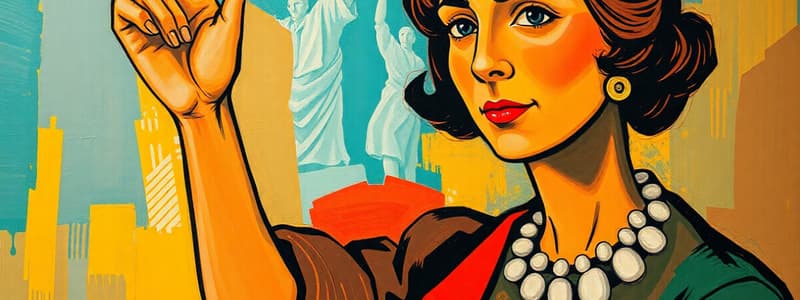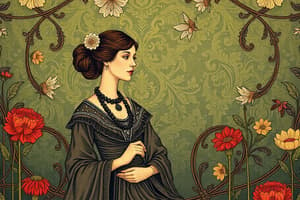Podcast
Questions and Answers
Match the following women with their significant contributions to the women's suffrage movement:
Match the following women with their significant contributions to the women's suffrage movement:
Abigail Adams = Urged her husband to "remember the ladies" and advocated for women's representation in government Mary Wollstonecraft = Argued in her book "A Vindication of the Rights of Woman" that women's low status was due to lack of education Margaret Fuller = Advocated for political equality and a more public life for women in her book "Woman in the Nineteenth Century" Alice Paul = Led the militant wing of the suffrage movement, using tactics like hunger strikes and protests to achieve the right to vote
Match the following events with their corresponding figures:
Match the following events with their corresponding figures:
The phrase "remember the ladies" = Abigail Adams A Vindication of the Rights of Woman = Mary Wollstonecraft Woman in the Nineteenth Century = Margaret Fuller The militant tactics of hunger strikes and protests = Alice Paul
Match the following figures with their actions:
Match the following figures with their actions:
Abigail Adams = Urged her husband, John Adams, to consider women's rights Mary Wollstonecraft = Wrote a book arguing for women's education and rights Margaret Fuller = Spoke out for women's political rights and broader societal roles Alice Paul = Used militant tactics to push for women's right to vote
Match the following figures with their notable works:
Match the following figures with their notable works:
Match the following figures with their primary goals:
Match the following figures with their primary goals:
Match the following figures with their contemporaries:
Match the following figures with their contemporaries:
Match the following actions with the person who performed them.
Match the following actions with the person who performed them.
Match the following events with their respective dates.
Match the following events with their respective dates.
Match the following people with their roles in the suffrage movement.
Match the following people with their roles in the suffrage movement.
Match the following tactics used by suffragists with their impact.
Match the following tactics used by suffragists with their impact.
Match the following places with their significance in the suffrage movement.
Match the following places with their significance in the suffrage movement.
Match the following terms with their meanings as used in the passage.
Match the following terms with their meanings as used in the passage.
Match the following phrases with the emotions they convey.
Match the following phrases with the emotions they convey.
Match the following situations with the actions Alice Paul took in response.
Match the following situations with the actions Alice Paul took in response.
Match Alice Paul's early experiences with their corresponding descriptions:
Match Alice Paul's early experiences with their corresponding descriptions:
Match the events in Alice Paul's life with their significance:
Match the events in Alice Paul's life with their significance:
Match the educational experiences of Alice Paul with their outcomes:
Match the educational experiences of Alice Paul with their outcomes:
Match the people in Alice Paul's life with their influence:
Match the people in Alice Paul's life with their influence:
Match the characteristics of Alice Paul with her actions:
Match the characteristics of Alice Paul with her actions:
Match the timeline events with their years:
Match the timeline events with their years:
Match the locations in Alice Paul's life with their significance:
Match the locations in Alice Paul's life with their significance:
Match the slogans or ideas associated with suffragism to their meanings:
Match the slogans or ideas associated with suffragism to their meanings:
Flashcards
Who was Alice Paul?
Who was Alice Paul?
Alice Paul was a leader in the women's suffrage movement, known for her aggressive tactics and commitment to achieving voting rights for women. She was both a Quaker and a militant suffragist, a contrast that reflects her personal evolution.
What was Alice Paul's early life like?
What was Alice Paul's early life like?
Alice Paul's early life was shaped by her upbringing in a Quaker family, where she was sheltered from the outside world. This upbringing emphasized peace and quiet, contrasting sharply with her later actions as a suffragist.
Why did Alice Paul shift away from social work?
Why did Alice Paul shift away from social work?
Alice Paul's involvement in social work in New York City led her to realize that her efforts weren't significantly impacting the lives of the poor. This realization prompted her to seek more impactful avenues for change.
What event sparked Alice Paul's commitment to the women's suffrage movement
What event sparked Alice Paul's commitment to the women's suffrage movement
Signup and view all the flashcards
What methods did Alice Paul use to fight for women's suffrage?
What methods did Alice Paul use to fight for women's suffrage?
Signup and view all the flashcards
How did Alice Paul's involvement shape the women's suffrage movement?
How did Alice Paul's involvement shape the women's suffrage movement?
Signup and view all the flashcards
What are the historical roots of women's suffrage?
What are the historical roots of women's suffrage?
Signup and view all the flashcards
What can we learn from Alice Paul's life story?
What can we learn from Alice Paul's life story?
Signup and view all the flashcards
Abigail Adams
Abigail Adams
Signup and view all the flashcards
Mary Wollstonecraft
Mary Wollstonecraft
Signup and view all the flashcards
Margaret Fuller
Margaret Fuller
Signup and view all the flashcards
Alice Paul
Alice Paul
Signup and view all the flashcards
Hunger Strike
Hunger Strike
Signup and view all the flashcards
Force Feeding
Force Feeding
Signup and view all the flashcards
Women's Suffrage Movement
Women's Suffrage Movement
Signup and view all the flashcards
National American Woman Suffrage Association (NAWSA)
National American Woman Suffrage Association (NAWSA)
Signup and view all the flashcards
The Congressional Union
The Congressional Union
Signup and view all the flashcards
The Women's Suffrage Parade of 1913
The Women's Suffrage Parade of 1913
Signup and view all the flashcards
Picketing the White House
Picketing the White House
Signup and view all the flashcards
Alice Paul's Incarceration
Alice Paul's Incarceration
Signup and view all the flashcards
Alice Paul's Resilience
Alice Paul's Resilience
Signup and view all the flashcards
Alice Paul's Legacy
Alice Paul's Legacy
Signup and view all the flashcards
The Equal Rights Amendment
The Equal Rights Amendment
Signup and view all the flashcards
Alice Paul's Complex Legacy
Alice Paul's Complex Legacy
Signup and view all the flashcards
Study Notes
Alice Paul: A Suffragist Leader
- Alice Paul was a Quaker girl who became a militant suffragist
- She experienced both a quiet upbringing and forceful activism
- Her background included a peaceful Quaker family in New Jersey
- She was sheltered from the outside world
- Her mother took her to suffrage meetings
- Became interested in women's suffrage at an early age
- Attended Swarthmore College, then social work in NYC
- Realized social work wasn't her calling, she pursued graduate studies in the US and England
- Learned from Christabel Pankhurst in England
- She became involved in political protests and activism in England
- Was arrested and force-fed multiple times in English prisons for participating in protests
- Formed the Congressional Union to push for women's suffrage
- Formed a powerful alliance with Lucy Burns
- Founded the National Woman's Party in 1916
- Organized pickets and protests outside the White House in 1917
- Faced opposition and arrest, but increased public attention to the cause
- Was arrested, jailed, and force-fed numerous times for her activism
- Helped secure enough support and votes for the 19th Amendment to pass.
- Wrote the Equal Rights Amendment in 1923, addressing gender inequality.
- Continued advocating for women's equality throughout her life.
Key Political Events
- The 19th Amendment was ratified in 1920, granting women the right to vote in the US
- The National Woman's Party was founded in 1916.
- Early suffragists like Abigail Adams advocated for women's rights during the drafting of the US Constitution.
- Alice Paul initially worked with other suffrage groups and activists in the US and England.
Studying That Suits You
Use AI to generate personalized quizzes and flashcards to suit your learning preferences.



